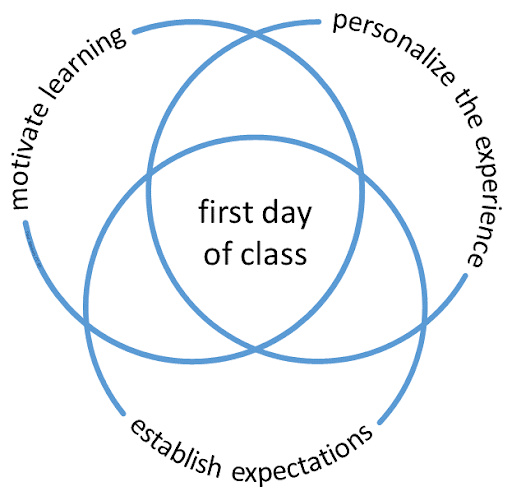What you do on your first day of class establishes the learning environment for the rest of your course, so it’s critical to think and plan carefully.

- You want every student to leave the first class thinking:
- This will be a good course.
- I’m okay, I’m safe being here.
- I have something valuable to contribute.
- Therefore, the first day of class isn’t a great day to wing it.
- If you don’t spend time establishing the learning environment but instead, simply “go over the syllabus” or launch right into Topic 1, students who are most likely to see the subject as worth learning are those whose backgrounds, and corresponding attitudes, are most like that of the instructor. Those students whose backgrounds are different, which by definition (usually) includes most members of under-represented groups, will be less likely to understand the appeal of the subject and consequently more inclined to put their efforts into pursuing some other discipline.
This excellent resource (PDF) from the Carl Wieman Science Education Initiative contains dozens of suggestions for what you could do. There isn’t time to do them all.
Go ahead and download this list and print this Venn diagram [reproduced above]. For each item A, B, C,… (and others you add to the list) decide for yourself if the item motivates learning, personalizes the experience for the student, and/or establishes expectations. When you’re done, perhaps the items at the center of the Venn diagram – the items that do all three simultaneously – are the ones to build into your first class. That way, you can be the most efficient and effective in the limited time you have with your students.
I think you’ll find, for example, that when an item clearly establishes expectations and personalizes the experience, with just a small change in how you present it or build it into your class syllabus or policies, you can also motivate learning.
What you do (and don’t do) in your first class is up to you, of course. Here are some first day of class do’s and don’ts for you to consider.
| DO | DON’T |
Check out the classroom before the first class
|
|
| Start the class on time (establish expectations!) |
|
Tell students you think they can all succeed if they put in the effort (growth mindset). It’s fine to say the course is challenging (after all, shouldn’t it be?) as long as you also let them know the course is
|
Say threatening things like:
|
Give them an authentic experience of what the class will be like.
|
Use teaching practices that are inconsistent with how you’ll teach the rest of the course. |
| Model academic integrity, today and every day. Address it when it’s needed: discuss plagiarism in Week 3 when you assign the first essay. | Emphasize penalties for academic misconduct and all the ways a student can be kicked out of the university.
|
End the class on time with a slide containing the most valuable information, just in case a lost student missed the first few minutes of the class:
|
End the class early (establishes the wrong expectation) or end the class late (be kind to your anxious, exhausted colleague who’s trying to get into the classroom to set up their first class!) |
| Repeat vital information (your preferred name, contact info, Important Thing) at the begin of second class |
“Planning Your First Day of Class” by Peter Newbury is licensed under a Creative Commons Attribution 4.0 International License, excerpted.
1/17/23 EJI
For more information or help, please email the Office for Faculty Excellence or make an appointment with a consultant.
